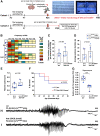Investigation of MicroRNA-134 as a Target against Seizures and SUDEP in a Mouse Model of Dravet Syndrome
- PMID: 36240080
- PMCID: PMC9522462
- DOI: 10.1523/ENEURO.0112-22.2022
Investigation of MicroRNA-134 as a Target against Seizures and SUDEP in a Mouse Model of Dravet Syndrome
Abstract
Dravet syndrome (DS) is a catastrophic form of pediatric epilepsy mainly caused by noninherited mutations in the SCN1A gene. DS patients suffer severe and life-threatening focal and generalized seizures which are often refractory to available anti-seizure medication. Antisense oligonucleotides (ASOs) based approaches may offer treatment opportunities in DS. MicroRNAs are short noncoding RNAs that play a key role in brain structure and function by post-transcriptionally regulating gene expression, including ion channels. Inhibiting miRNA-134 (miR-134) using an antimiR ASO (Ant-134) has been shown to reduce evoked seizures in juvenile and adult mice and reduce epilepsy development in models of focal epilepsy. The present study investigated the levels of miR-134 and whether Ant-134 could protect against hyperthermia-induced seizures, spontaneous seizures and mortality (SUDEP) in F1.Scn1a(+/-)tm1kea mice. At P17, animals were intracerebroventricular injected with 0.1-1 nmol of Ant-134 and subject to a hyperthermia challenge at postnatal day (P)18. A second cohort of P21 F1.Scn1a(+/-)tm1kea mice received Ant-134 and were followed by video and EEG monitoring until P28 to track the incidence of spontaneous seizures and SUDEP. Hippocampal and cortical levels of miR-134 were similar between wild-type (WT) and F1.Scn1a(+/-)tm1kea mice. Moreover, Ant-134 had no effect on hyperthermia-induced seizures, spontaneous seizures and SUDEP incidence were unchanged in Ant-134-treated DS mice. These findings suggest that targeting miR-134 does not have therapeutic applications in DS.
Keywords: Dravet syndrome; SUDEP; miR-134; oligonucleotides; seizure.
Copyright © 2022 Gerbatin et al.
Figures



Similar articles
-
Life-span characterization of epilepsy and comorbidities in Dravet syndrome mice carrying a targeted deletion of exon 1 of the Scn1a gene.Exp Neurol. 2022 Aug;354:114090. doi: 10.1016/j.expneurol.2022.114090. Epub 2022 Apr 26. Exp Neurol. 2022. PMID: 35487274
-
Antisense oligonucleotides increase Scn1a expression and reduce seizures and SUDEP incidence in a mouse model of Dravet syndrome.Sci Transl Med. 2020 Aug 26;12(558):eaaz6100. doi: 10.1126/scitranslmed.aaz6100. Sci Transl Med. 2020. PMID: 32848094
-
A novel rat model of Dravet syndrome recapitulates clinical hallmarks.Neurobiol Dis. 2023 Aug;184:106193. doi: 10.1016/j.nbd.2023.106193. Epub 2023 Jun 8. Neurobiol Dis. 2023. PMID: 37295561
-
Genetic therapeutic advancements for Dravet Syndrome.Epilepsy Behav. 2022 Jul;132:108741. doi: 10.1016/j.yebeh.2022.108741. Epub 2022 May 30. Epilepsy Behav. 2022. PMID: 35653814 Review.
-
SCN1A-related phenotypes: Epilepsy and beyond.Epilepsia. 2019 Dec;60 Suppl 3:S17-S24. doi: 10.1111/epi.16386. Epilepsia. 2019. PMID: 31904117 Review.
Cited by
-
How Soon is Soon Enough? Consideration of Timing and Disease Etiology for microRNAs in Epilepsy.Epilepsy Curr. 2025 Aug 11:15357597251366441. doi: 10.1177/15357597251366441. Online ahead of print. Epilepsy Curr. 2025. PMID: 40809870 Free PMC article. Review.
-
Engineering a human-based translational activator for targeted protein expression restoration.bioRxiv [Preprint]. 2025 Jul 9:2025.07.09.663984. doi: 10.1101/2025.07.09.663984. bioRxiv. 2025. PMID: 40672171 Free PMC article. Preprint.
-
Voltage-gated sodium channels in excitable cells as drug targets.Nat Rev Drug Discov. 2025 May;24(5):358-378. doi: 10.1038/s41573-024-01108-x. Epub 2025 Feb 3. Nat Rev Drug Discov. 2025. PMID: 39901031 Review.
-
Heat-induced seizures, premature mortality, and hyperactivity in a novel Scn1a nonsense model for Dravet syndrome.Front Cell Neurosci. 2023 May 3;17:1149391. doi: 10.3389/fncel.2023.1149391. eCollection 2023. Front Cell Neurosci. 2023. PMID: 37206664 Free PMC article.
References
-
- Campbell A, Morris G, Sanfeliu A, Augusto J, Langa E, Kesavan JC, Nguyen NT, Conroy RM, Worm J, Kielpinski L, Jensen MA, Miller MT, Kremer T, Reschke CR, Henshall DC (2022) AntimiR targeting of microRNA-134 reduces seizures in a mouse model of Angelman syndrome. Mol Ther Nucleic Acids 28:514–529. 10.1016/j.omtn.2022.04.009 - DOI - PMC - PubMed
-
- Fisher RS, Acevedo C, Arzimanoglou A, Bogacz A, Cross JH, Elger CE, Engel J Jr, Forsgren L, French JA, Glynn M, Hesdorffer DC, Lee BI, Mathern GW, Moshé SL, Perucca E, Scheffer IE, Tomson T, Watanabe M, Wiebe S (2014) ILAE official report: a practical clinical definition of epilepsy. Epilepsia 55:475–482. 10.1111/epi.12550 - DOI - PubMed
Publication types
MeSH terms
Substances
Supplementary concepts
LinkOut - more resources
Full Text Sources
Medical
Molecular Biology Databases
